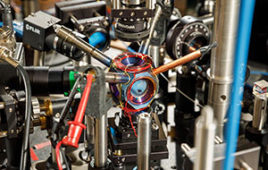 CAL Analytics, a company specializing in the development of automated and autonomous systems, will receive funding from the Ohio Department of Transportation (ODOT) office of Statewide Planning & Research to conduct research on “Open Framework Standards for A Combined Aircraft Sensor Network.” The research objective is to develop a means to detect and track lower altitude aircraft in Ohio.
CAL Analytics, a company specializing in the development of automated and autonomous systems, will receive funding from the Ohio Department of Transportation (ODOT) office of Statewide Planning & Research to conduct research on “Open Framework Standards for A Combined Aircraft Sensor Network.” The research objective is to develop a means to detect and track lower altitude aircraft in Ohio.
Despite substantial progress made in the communications and navigation domains, the ability to provide accurate, robust and scalable surveillance services, particularly for lower altitude airspace, is the biggest obstacle for wide-use operations of unmanned aerial systems (UAS) and optionally piloted aircraft (OPA). CAL Analytics’ research aims to fill this gap by developing open requirements and interface standards for efficiently growing and scaling Ohio’s emerging airspace surveillance capability for lower altitude operations. The research project began after July 1, 2021, and is led by CAL Analytics managing director, Dr. Sean Calhoun.
“This research will lay out the foundation for Ohio to develop a robust network of low-altitude surveillance services across the state and thus enabling a whole host of UAS operations such as package delivers and Urban Air Mobility (UAM),” said Dr. Calhoun. “By standardizing these services, the state will remove some of the uncertainty from public and private partners, allowing for easier integration within the state.”
The CAL Analytics research team will draw upon its experience with projects like the Air Force Research Laboratory SkyVision Ground-Based Detect and Avoid (GBDAA) system, DriveOhio/FlyOhio initiatives as well as the ODOT Unmanned Aircraft System Traffic Management (UTM) Corridor, and the Ohio Federal Research Network’s (OFRN) Contingency Management Platform (CMP) to define the requirements for a lower altitude surveillance clearinghouse. Partnering agencies on this project include The Ohio State University, Gannett Flemming – GeoDecisions, Kent State University, and Converge Technologies.
“As the Advanced Air Mobility (AAM) market continues to grow in Ohio and the Nation, the urgency to reduce and deter threats and survey larger areas in less time heightens. CAL Analytics’ selection to conduct this revolutionary research for the state is spot on, and we are honored to partner with the company’s research team and ODOT to maintain our state’s security,” said Bob Tanner, OFRN director. OFRN is an Ohio Department of Higher Education program managed by Parallax Advanced Research.
CAL Analytics’ research will study surveillance sources, functional requirements, high-level functional designs and financial and legal analyses of Ohio’s AAM market. The final research will provide ODOT an understanding of future trends and technologies relating to lower altitude surveillance for airspace operations, and how to expand lower altitude surveillance capabilities. ODOT will also share the research data with other state agencies working on detection and tracking trends and technologies.
ODOT-funded research projects address transportation concerns before they become critical problems. Results from these projects provide important information. And tools that State-level decision-makers require to ensure that Ohio’s transportation system keeps up with evolving transportation needs.
“Low-altitude detection and tracking technology will be a game-changer for advanced air mobility solutions,” said Howard Wood, executive director of DriveOhio. “Groundbreaking research like this directly supports ODOT and DriveOhio’s statewide strategy for advanced aviation, which is focused on the movement of people and goods. Once we’re able to track low-altitude aircraft, operators will feel confident in safely flying long distances without fear of collision.”





Tell Us What You Think!